LGALS3
-
Official Full Name
lectin, galactoside-binding, soluble, 3
-
Overview
This gene encodes a member of the galectin family of carbohydrate binding proteins. Members of this protein family have an affinity for beta-galactosides. The encoded protein is characterized by an N-terminal proline-rich tandem repeat domain and a single C-terminal carbohydrate recognition domain. This protein can self-associate through the N-terminal domain allowing it to bind to multivalent saccharide ligands. This protein localizes to the extracellular matrix, the cytoplasm and the nucleus. This protein plays a role in numerous cellular functions including apoptosis, innate immunity, cell adhesion and T-cell regulation. Alternate splicing results in multiple transcript variants -
Synonyms
L31; GAL3; MAC2; CBP35; GALBP; GALIG; LGALS3; Galactose specific lectin 3; L34; L-31; L-34; Laminin binding protein; Lectin L 29; MGC105387; Galectin-3; LGALS3; CBP35; GAL3; GALBP; GALIG; L31; LGALS2; MAC2; 35 kDa lectin; IgE-binding protein; MAC-2 antigen; carbohydrate-binding protein 35; galactose-specific lectin 3; laminin-binding protein; lectin L-29;
- Recombinant Proteins
- Cell & Tissue Lysates
- Protein Pre-coupled Magnetic Beads
- Chicken
- Human
- Mouse
- Rabbit
- Rat
- Rhesus Macaque
- E. coli
- E.coli
- HEK293
- HEK293F
- HEK293T
- Human
- Mamanlian cells
- Mammalian Cell
- Mammalian cells
- C
- His
- Flag
- GST
- His (Fc)
- Avi
- His(N
- ter)
- His|GST
- Myc
- DDK
- MYC
- Myc|DDK
- N/A
- N
- Background
- Quality Guarantee
- Case Study
- Involved Pathway
- Protein Function
- Interacting Protein
- LGALS3 Related Articles
- LGALS3 Related Research Area
What is LGALS3 protein?
LGALS3 (galectin 3) gene is a protein coding gene which situated on the long arm of chromosome 14 at locus 14q22. This gene encodes a member of the galectin family of carbohydrate binding proteins. Members of this protein family have an affinity for beta-galactosides. The encoded protein is characterized by an N-terminal proline-rich tandem repeat domain and a single C-terminal carbohydrate recognition domain. This protein can self-associate through the N-terminal domain allowing it to bind to multivalent saccharide ligands. The LGALS3 protein is consisted of 454 amino acids and its molecular mass is approximately 51.7 kDa.
What is the function of LGALS3 protein?
This protein localizes to the extracellular matrix, the cytoplasm and the nucleus. This protein plays a role in numerous cellular functions including apoptosis, innate immunity, cell adhesion and T-cell regulation. Galectin-3 mediates with the alpha-3, beta-1 integrin the stimulation by cspg4 of endothelial cells migration. Galectin-3 plays an necessary part during the acquisition of vasculogenic mimicry and angiogenic properties associated with melanoma progression. LGALS3 overexpression is highly expressed in early stages of papillary carcinoma, and its expression intensity declines during tumor progression.
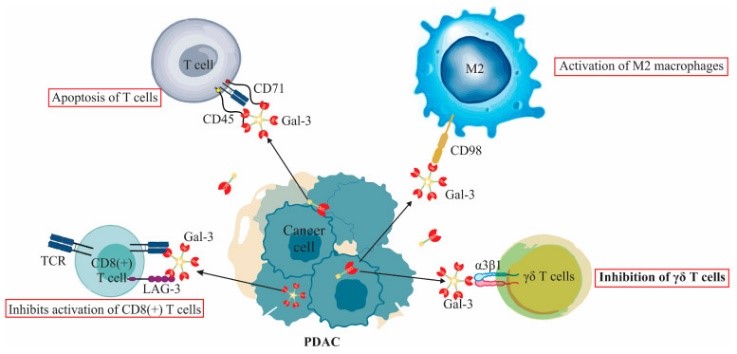
Fig1. Extracellular functions of Galectin-3 (Gal-3) in PDAC immune modulation. (Milica Dimitrijevic Stojanovic, 2023)
LGALS3 Related Signaling Pathway
LGALS3 can participate in biological processes such as cell proliferation, differentiation and apoptosis by activating MAPK (including ERK, JNK and p38) signaling pathways. LGALS3 can affect the activity of Wnt/β-catenin signaling pathway and PI3K/AKT signaling pathway to regulate cell proliferation and migration. LGALS3 activates the NF-κB signaling pathway, which promotes inflammation and immune responses. LGALS3 is also associated with several other signaling pathways and biological processes, such as TGF-β signaling pathway, JAK/STAT signaling pathway, and autophagy.
LGALS3 Related Diseases
LGALS3 is abnormally expressed in a variety of cancers, including lung, breast, and colorectal cancers. It can promote the proliferation, invasion and metastasis of tumor cells by activating PI3K/AKT, Wnt/β-catenin and NF-κB signaling pathways. The study found that mutations in the LGALS3 gene are associated with the development of diabetes. LGALS3 can promote the proliferation and migration of vascular smooth muscle cells by activating MAPK/ERK signaling pathway, thus participating in the occurrence and development of atherosclerosis, which may be related to the occurrence and development of obesity.
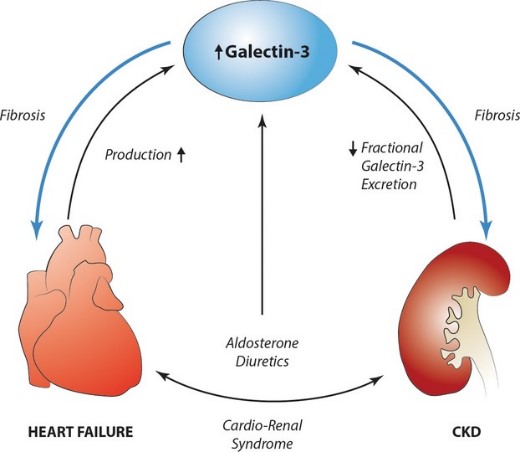
Fig2. The role of galectin-3 in the cardiorenal syndrome. (Wouter C Meijers, 2014)
Bioapplications of LGALS3
LGALS3 is abnormally expressed in a variety of tumors and therefore can be used as a potential tumor marker. By detecting the level of LGALS3 in serum or tissue, it can help diagnose certain types of cancer, such as breast cancer, prostate cancer, etc. LGALS3 can accelerate wound healing by promoting cell proliferation, migration, and angiogenesis, and may have potential applications in wound repair, fracture healing, and nerve regeneration. LGALS3 is an important biomarker that can be used for drug screening and evaluation.
High Purity
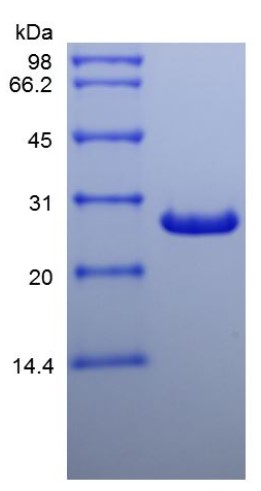
Fig1. SDS-PAGE (LGALS3-4952H) (PROTOCOL for western blot)
.
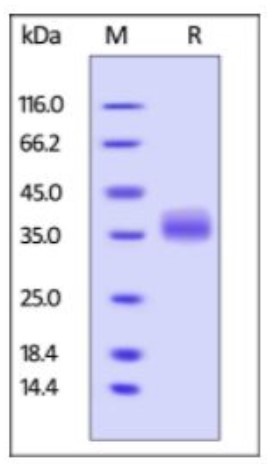
Fig2. SDS-PAGE (LGALS3-276H) (PROTOCOL for western blot)
Case study 1: Sebastian Bänfer, 2018
The beta-galactoside binding lectin galectin-3 (Gal3) is found intracellularly and in the extracellular space. Secretion of this lectin is mediated independently of the secretory pathway by a not yet defined nonclassical mechanism. Superresolution and electron microscopy studies visualized Gal3 recruitment and sorting into intraluminal vesicles and the team found Gal3 in the lumen of exosomes in this study. Exosomal Gal3 release depends on the endosomal sorting complex required for transport I (ESCRT-I) component Tsg101 and functional Vps4a. In addition, the researchers identified a highly conserved tetrapeptide P(S/T)AP motif in the amino terminus of Gal3 that mediates a direct interaction with Tsg101. Here the team conclude that Gal3 is a member of endogenous non-ESCRT proteins which are P(S/T)AP tagged for exosomal release.
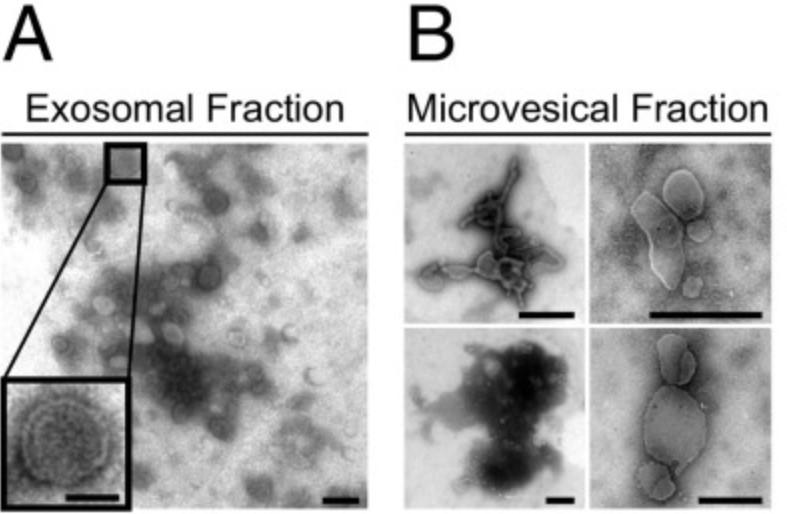
Fig1. Gal3 is contained in exosomes. (A and B) The 100,000 × g pellets (exosomes) (A) or the 10,000 × g pellets (microvesicles) (B) were subjected to negative staining for electron microscopy. Inset shows the typical appearance of an exosome.
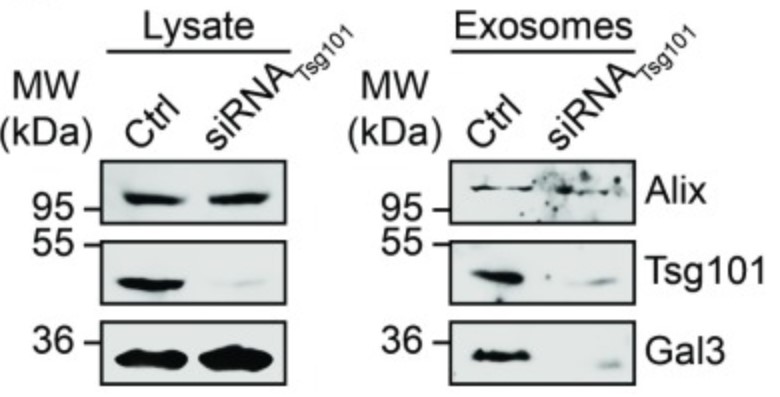
Case study 2: Annett Koch, 2010
Galectin-3 is a beta-galactoside-binding protein widely expressed in all epithelia where it is involved in tissue homeostasis and cancer progression. The researchers investigated the potential role of galectin-3 on early events in polarization of epithelial renal cells, using three-dimensional cultures of MDCK cells and also galectin-3 null mutant mouse kidneys. The results show that depletion in galectin-3 systematically leads to severe perturbations of microtubular network associated with defects in membrane compartimentation, both in vitro and in vivo. Moreover, the absence of galectin-3 impinges on the morphology of the primary cilium, which is three times longer and unusually shaped. Collectively, these data establish galectin-3 as a key determinant in epithelial morphogenesis via its effect on centrosome biology.
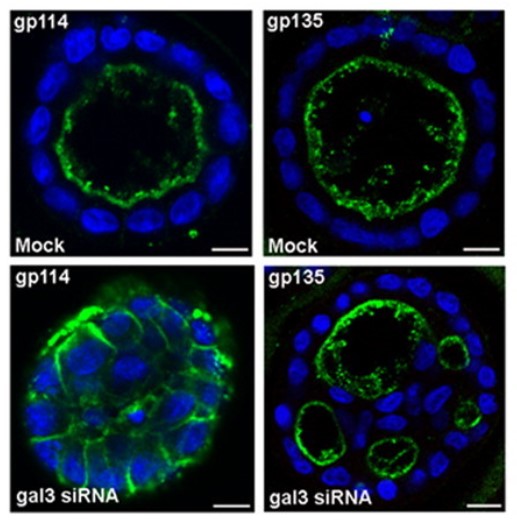
Fig3. Depletion of galectin-3 leads to abnormal cystogenesis in MDCK cells. MDCK cells were cultured in Matrigel 3D matrix for 5 d.
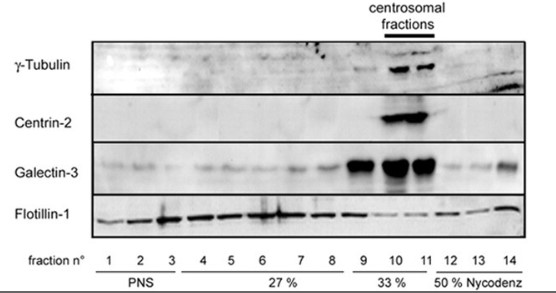
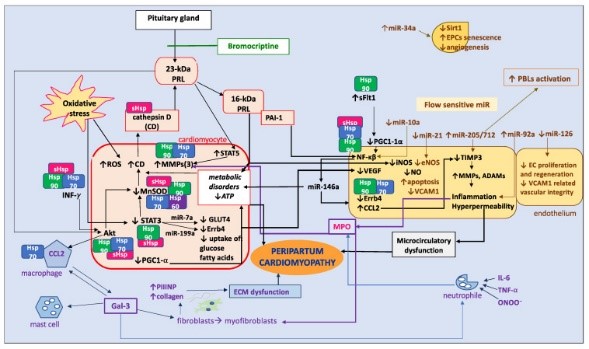
Fig1. Pathophysiology of peripartum cardiomyopathy (PPCM), changed based on the results of the paper by Hilfiker-Kleiner et al. (Karolina E Kryczka, 2024)
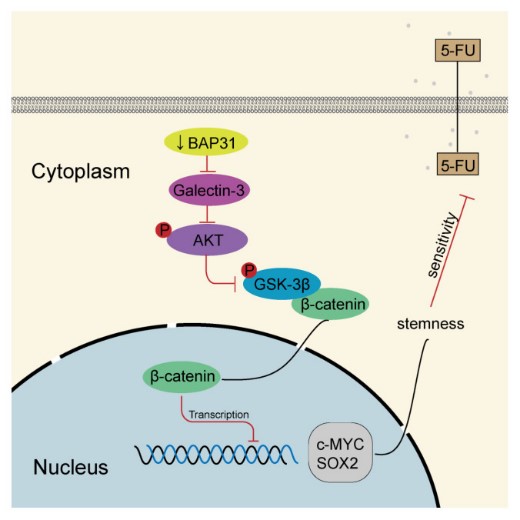
Fig2. Schematic model of knockdown of BAP31 downregulating galectin-3 to inhibit Wnt/β-catenin signaling pathway to modulate 5-FU chemosensitivity and cancer stemness in colorectal cancer. (Jingjing Liu, 2023)
LGALS3 involved in several pathways and played different roles in them. We selected most pathways LGALS3 participated on our site, such as AGE/RAGE pathway, Advanced glycosylation endproduct receptor signaling, Hedgehog signaling events mediated by Gli proteins, which may be useful for your reference. Also, other proteins which involved in the same pathway with LGALS3 were listed below. Creative BioMart supplied nearly all the proteins listed, you can search them on our site.
| Pathway Name | Pathway Related Protein |
|---|---|
| AGE/RAGE pathway | AGER;MAPK14;JUN;MMP13;EGFR;ATF2;CHUK;TIRAP;LGALS3 |
| Advanced glycosylation endproduct receptor signaling | S100B;ALCAMB;AGER;SAA1;APPA;APPB;LGALS3;S100A12;DDOST |
| Hedgehog signaling events mediated by Gli proteins | IFT88;MTSS1;CSNK1G2;CSNK1G3;SAP30;SPOP;SIN3B;SAP18;KIF3A |
| Immune System | TRIM6;GBP4;RNF144B;IFIT10;RNF138;CTSK;PIK3AP1;SIGLEC5;GBP1 |
| Innate Immune System | DEFB129;MYO1C;BAIAP2;CRP;BTR29;DEFB104A;MGC174857;PELI1;TLR10 |
| Spinal Cord Injury | RTN4;LILRB3;TNFSF13B;RTN4R;KLK8;LGALS3;MBP;AIF1;OMG |
LGALS3 has several biochemical functions, for example, IgE binding, carbohydrate binding, chemoattractant activity. Some of the functions are cooperated with other proteins, some of the functions could acted by LGALS3 itself. We selected most functions LGALS3 had, and list some proteins which have the same functions with LGALS3. You can find most of the proteins on our site.
| Function | Related Protein |
|---|---|
| IgE binding | LGALS3;FCER2;FCER1G;CD247L;Fcer2a;MS4A2;FCER1A |
| carbohydrate binding | FREM1;CLEC1A;CLEC5A;AIM1;GALNT10;LGALS3L;Siglec1;KLRB1;WBSCR17 |
| chemoattractant activity | CXCL12B;FGF8;SAA2;NTF3;FGF10;SCG2;CCL5;FIGF;PDGFB |
| laminin binding | ECM1;CTSS;LGALS2A;RPSA;NID1;BCAM;ITGB1;ITGA3;LYPD5 |
| poly(A) RNA binding | TRA2A;TSR1;C14orf166;GPATCH8;DHX15;DHX8;PUF60;EIF1AX;TES |
| protein binding | PVRL3;ATP2B4;PPP5C;VTA1;C2orf29;PSMB10;ARID1A;NUP205;SDC1 |
LGALS3 has direct interactions with proteins and molecules. Those interactions were detected by several methods such as yeast two hybrid, co-IP, pull-down and so on. We selected proteins and molecules interacted with LGALS3 here. Most of them are supplied by our site. Hope this information will be useful for your research of LGALS3.
SS18L1; CD6; GOLGA2; PPIG; ALCAM; PRR13; AHSG; MICA
- Q&As
- Reviews
Q&As (7)
Ask a questionLGALS3 has been investigated as a potential diagnostic and prognostic marker in various types of cancer. Its expression levels have been correlated with tumor stage, grade, and patient survival. LGALS3 can be detected in blood, urine, and tissue samples, making it a promising biomarker for non-invasive cancer detection and monitoring. Additionally, LGALS3 expression patterns, subcellular localization, and glycosylation status have been associated with specific cancer subtypes and clinical outcomes, providing insights into disease progression and patient prognosis.
The expression of LGALS3 is regulated at multiple levels, including transcriptional, post-transcriptional, and post-translational regulation. Transcription factors, such as Sp1, AP-1, and NF-κB, bind to the promoter region of the LGALS3 gene and regulate its expression. Epigenetic modifications, including DNA methylation and histone acetylation, can also influence LGALS3 expression. Additionally, microRNAs and RNA-binding proteins can regulate the stability and translation of LGALS3 mRNA. Moreover, various extracellular signals, such as cytokines and growth factors, can modulate LGALS3 expression in a tissue-specific and context-dependent manner.
LGALS3, also known as galectin-3, is a multifunctional protein involved in various cellular processes. It plays a role in cell adhesion, migration, apoptosis, immune response, and inflammation. LGALS3 can interact with glycosylated proteins and lipids, modulating their functions and signaling pathways. It also acts as a receptor for extracellular matrix proteins and plays a role in tissue remodeling. Additionally, LGALS3 has been implicated in cancer progression and metastasis, as well as in the regulation of fibrosis and wound healing.
Targeting LGALS3 has emerged as a potential therapeutic strategy in cancer treatment. Inhibition of LGALS3 expression or activity can impede tumor cell survival, migration, and invasion. Additionally, blocking LGALS3-mediated immune evasion mechanisms could enhance anti-tumor immune responses. Various approaches, such as small molecule inhibitors, antibodies, and gene silencing techniques, have been explored to target LGALS3 in preclinical and clinical studies. However, further research is needed to optimize these strategies and evaluate their efficacy and safety in cancer patients.
LGALS3 plays a critical role in immune response and inflammation. It can modulate the activation and function of immune cells, including macrophages, dendritic cells, and T cells. LGALS3 can promote cell adhesion and migration, facilitating immune cell recruitment to sites of inflammation. It also regulates the production of pro-inflammatory cytokines and chemokines, and can act as a chemoattractant for immune cells. Additionally, LGALS3 can modulate the clearance of apoptotic cells and regulate the resolution of inflammation.
LGALS3 contains a conserved carbohydrate recognition domain (CRD) that allows it to bind to glycosylated proteins and lipids. The CRD is responsible for LGALS3's interaction with specific glycan structures, mediating its diverse functions. LGALS3 also has a N-terminal domain involved in protein-protein interactions and a C-terminal domain that regulates its oligomerization. Moreover, LGALS3 can undergo post-translational modifications, such as phosphorylation and glycosylation, which can affect its localization, stability, and function.
LGALS3 has been implicated in various aspects of cancer progression and metastasis. It can promote tumor cell survival, migration, invasion, and angiogenesis. LGALS3 is involved in the modulation of epithelial-mesenchymal transition (EMT), a process essential for cancer cell metastasis. It also interacts with components of the extracellular matrix, promoting tumor cell adhesion and invasion. Furthermore, LGALS3 can influence immune evasion mechanisms employed by cancer cells, contributing to tumor immune escape and resistance to therapy.
Customer Reviews (3)
Write a reviewMy experimentation flourishes, as if guided by the hands of magic, all thanks to this extraordinary reagent.
Compared to similar products, this reagent demonstrates superior cost-effectiveness, satisfying both in terms of quality and price.
The storage conditions for the reagent are simple and do not require special storage environments.
Ask a Question for All LGALS3 Products
Required fields are marked with *
My Review for All LGALS3 Products
Required fields are marked with *


